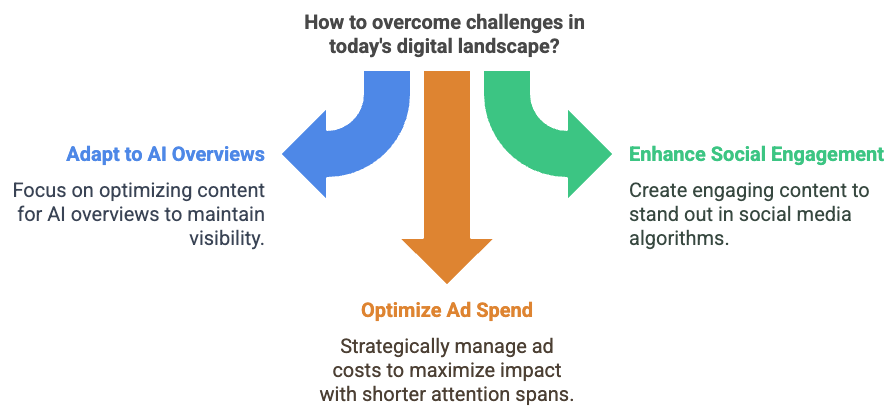How to Convert More Website Visitors Into Leads (Without Needing More Traffic)
"Darrell, how do we get more traffic to our website?"
As a digital marketing strategist who's analyzed hundreds of business websites over the past 14 years, I hear this question constantly. Business owners open their analytics, point to fluctuating visitor numbers, and assume more traffic is the solution to their revenue problems.
Let me be direct: Traffic doesn't pay the bills.
I understand what you're really asking. You want more leads and sales, and you believe increased traffic is the pathway. But this mindset is causing you to miss the golden opportunity sitting right under your nose: the visitors you already have.
Why Chasing Traffic Is an Uphill Battle
Let's imagine your content went viral tomorrow, a social media post takes off or your blog gets shared thousands of times. Exciting as a million new visitors sounds, the harsh reality is that the vast majority of those people aren't your customers or even prospects.
Why? Because at any given time, only a small percentage of people are "in-market" and ready to buy what you're selling.
Viral traffic rarely translates to proportional revenue because most visitors simply aren't ready to purchase.
Today's digital landscape makes getting new traffic increasingly difficult:
- Google's AI overviews are reducing organic click-through rates
- Social media algorithms prioritize engagement over business content
- Ad costs continue to rise while attention spans shrink
The solution isn't working harder to get more visitors, it's working smarter with the visitors you already have.

What Does Your Website Analytics Actually Reveal?
In our 90-day sprint process with clients, we analyze visitor behavior through advanced Google Analytics techniques. What we consistently discover is revealing: visitors behave differently depending on how they enter your website.
For example:
- Blog visitors show different navigation patterns than homepage visitors
- Product page visitors exhibit different engagement signals than case study readers
- Each entry point represents a different level of buying intent
Understanding these patterns allows us to implement targeted strategies that maximize conversion potential based on actual visitor behavior, not guesswork.
How Do You Convert More Website Visitors Without More Traffic?
Let's focus on two high-impact strategies we implement during our 90-day sprint that can transform your results without needing more traffic.
Strategy #1: Create Targeted Exit Intent Offers for Different Website Sections
One of the quickest wins we implement is strategic exit intent offers. But here's where most businesses go wrong: they create a single generic pop-up for their entire website.
As I tell our agency clients, this is lazy marketing.
What makes an exit intent offer effective?
Let me illustrate with a real example. Imagine you own a plumbing company with a blog post about water heater repair.
When someone lands on this post, we can reasonably assume they either:
- Have a current water heater problem
- Know someone with a water heater issue
- Are concerned about potential water heater failures
If they're not ready to call you immediately, don't let them leave empty-handed.
As they move to exit, present them with a relevant resource, perhaps a "Free Guide: How to Maintain Your Water Heater to Prevent Costly Emergencies."

The key is relevance. Your exit intent offer must match the specific content they came to see.
Modern marketing tools like HubSpot, Salesforce, and even basic email platforms make creating targeted pop-ups simple, yet most businesses still show the same generic offer to all visitors.
How to implement targeted exit intent offers:
- Identify your website's main content categories (think of them like grocery store aisles)
- Create a specific, valuable resource for each category (guide, checklist, video)
- Set up exit intent triggers that only show on relevant content sections
- Hide these offers from visitors to other website sections
This approach typically converts an additional 1-3% of your current visitors into leads, without any new traffic.

Strategy #2: Provide Multiple Engagement Options Beyond "Get a Quote"
Just yesterday, I reviewed a website for a service business prospect in the Midwest. Their site looked fantastic, but had one critical flaw: the only engagement option was "Ask for a Free Quote."
This is perhaps the most common mistake I see across business websites.
If I'm not ready for a quote today (and most visitors aren't), you've given me no way to engage with your business. And here's the brutal truth: I'm probably never coming back.
Not because your reputation is poor or your service inadequate. It's simply because once I leave your site, I'll likely return to Google or social media and find one of your competitors who will provide value without requiring immediate commitment.
What engagement options should your website include?
Every website needs multiple engagement points that match different stages of the buyer's journey:
- Awareness Stage: Educational resources, free guides, problem-oriented content
- Consideration Stage: Case studies, comparison tools, methodology explanations
- Decision Stage: Consultations, quotes, demonstrations
By only offering decision-stage options like "Get a Quote," you're ignoring the 95% of visitors who aren't ready to buy today but could become customers in the future.

Real-world impact of multiple engagement options:
When we implement these engagement strategies for our clients, we consistently see conversion improvements of 1-3 percentage points.
While that might not sound significant initially, consider the impact:
If your website gets 10,000 monthly visitors and currently converts at 2% (generating 200 leads), increasing that to just 3% would give you 300 leads monthly, a 50% increase without a single additional visitor or dollar spent on advertising.
Why Visitors Who Leave Your Website Rarely Return
One uncomfortable truth that data consistently reveals: visitors who leave your website without engaging are unlikely to ever return.
This isn't because your business lacks value or reputation. It's because the digital ecosystem bombards consumers with information from every direction: social media, email, competitors, YouTube, and more.
Once a visitor leaves, the chance of them remembering to return specifically to your website drops dramatically. They'll likely find a solution elsewhere before they remember your brand.
This reality makes capturing visitors during their first visit absolutely critical. You simply can't count on them coming back later.

Two Real Business Examples of Conversion Optimization Success
Case Study #1: Local Service Business
A local service business came to our agency struggling with lead generation despite decent traffic. Their website had a single "Request a Quote" form with a 0.8% conversion rate.
By implementing:
- Section-specific exit intent offers
- A downloadable buyer's guide
- A simple quiz to help visitors identify their needs
Their conversion rate increased to 3.2% within 60 days, a 400% improvement generating 46 additional leads monthly without increasing traffic.
Case Study #2: B2B Software Company
A B2B software company was spending heavily on Google Ads but seeing poor conversion rates. Analysis revealed that 82% of their traffic was viewing informational content but had no relevant engagement options.
After implementing:
- Industry-specific white papers as exit offers
- A free assessment tool
- Educational webinar registrations
Their lead generation increased by 67% while simultaneously reducing their cost per lead by 41%.
How to Implement These Strategies on Your Website
Ready to stop leaving money on the table? Here's how to get started:
1. Audit your current website paths:
- Use Google Analytics to identify your top entry pages
- Analyze the content categories these pages fall into
- Note which pages have high exit rates
2. Create relevant resources for each content category:
- Develop downloadable guides, checklists, or videos
- Ensure each resource directly relates to the specific content section
- Make these resources genuinely valuable, not thinly disguised sales pitches
3. Implement targeted exit intent technology:
- Use your email marketing platform or website tools to create exit popups
- Set display rules based on page categories
- A/B test different offers to optimize performance
4. Add multiple engagement options throughout your site:
- Create landing pages for each resource
- Add clear calls-to-action that don't require immediate purchase commitment
- Ensure mobile visitors can easily access these options
5. Measure results and optimize:
- Track conversion rates by page and offer type
- Monitor lead quality from different engagement points
- Continuously refine based on performance data
Final Thoughts: Efficiency Beats Volume in Digital Marketing
In today's digital marketing landscape, efficiency is outperforming volume.
Rather than obsessing over traffic metrics, focus on maximizing the value of every visitor already coming to your site.
The two strategies we've covered, targeted exit intent offers and multiple engagement options, are proven to increase conversion rates by 1-3%. While this might seem modest, it can translate to a 50% increase in lead volume without spending another dollar on advertising.
As I often tell our inner circle members: traffic doesn't pay the bills, conversions do.
Ready to transform your website's performance?
Consider joining our marketing inner circle or take our AI Marketing Assessment that will provide you a comprehensive evaluation of your current positioning strategy and delivers a customized growth roadmap with clear action steps.


